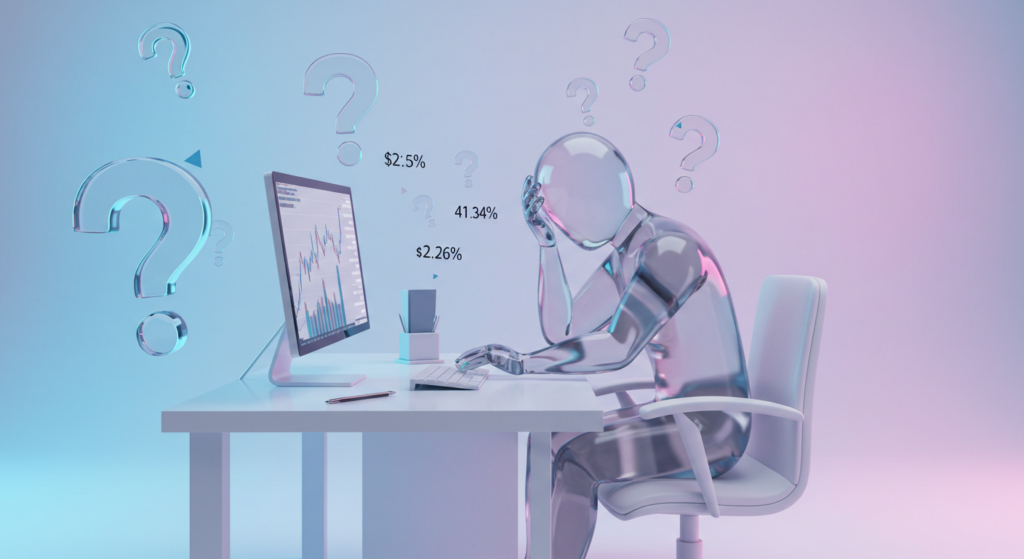
Identifying the perfect entry point, catching every big move, and knowing exactly when to buy or sell–sounds like a dream right? That’s probably because it is precisely that. Sorry to burst that bubble, but nobody can predict the market with certainty.
Many factors drive the financial world: political turmoil, natural disasters, central bank decisions, and market sentiments just to name a few. Truth is, no technical indicators or fundamental analyses can consistently tell you what will happen next.
While you cannot predict the future, you can learn how to play the odds. Understanding probability in trading can be the key to long-term success and the trading advantage you need to elevate your trades to the next level.
Why Traders Crave Certainty
Humans are wired to seek out patterns and predictability.
That’s why we point out familiar shapes in the clouds. Logic and structure comfort us–we want to believe that if X happens, Y will follow. That’s true for most things; if you drop something heavy on your foot, you know it will hurt. The problem is–markets don’t follow fixed rules.

A trap that many budding traders often fall for is the sweet-sounding “perfect strategy”–a mythical foolproof system that guarantees wins. They start chasing indicators, fine-tuning their settings, and overanalysing charts, believing that the more it’s refined, the more accurate their systems become.
Soon, they realise that no matter how much they analyse, the market will always be unpredictable in the short term. Trying to forecast every single move with certainty is a Sisyphean task.
Some traders believe that somewhere out there, a 100% accurate strategy exists. They search for strategies boasting 80-90% win rates, thinking they’ve cracked the code. But even the best traders–hedge fund managers, seasoned professionals, and top algorithmic traders–win only 50-60% of the time.
Trading: A Game of Probabilities
The market isn’t about being right–it’s about managing probabilities.
Imagine you have a coin weighted to land on heads 60% of the time. You know it has a statistical edge, but that doesn’t mean you’ll win every flip. You might get three tails in a row, but over 100 flips, heads should win around 60 times.

Trading works the same way. Even a profitable strategy will have losses because no setup is ever 100% guaranteed.
A trader using a 60% win rate strategy must understand that 40 out of 100 trades will be losses. The problem is, most traders emotionally react to short-term losses, abandoning solid strategies before they let probabilities play out.
Why Even Winners Can Lose Sometimes
Even a strong strategy will have losing streaks. If you trade long enough, you’re bound to experience:
- Five or more losing trades in a row (even if your strategy is profitable).
- A period where nothing seems to work out for you.
- A winning streak that makes you overconfident—then suddenly reverses.
This is why managing risk will always matter more than your win rate. If a couple of losses in a row breaks your mind and mettle–you might never make it to the winning trades that balance the equation.
Imagine this: Casinos don’t win every bet, but they have an edge over thousands and thousands of games–over time, the odds always play in their favour.
Backtesting: Not a Magical Crystal Ball
A valuable but oft-misunderstood tactic, backtesting is when traders test their strategies against historical data. While over-optimising their strategies to fit past price action can create a system that looks perfect, it cannot keep up with the ever-fluid market.

The goal of backtesting isn’t finding perfection, but to test if a strategy possesses statistical advantages that hold up over time.
The Truth on “High Accuracy” Strategies
While a high-win rate strategy (one that embraces the belief that an 80-90% accuracy rate means raking in easy profits) sounds universally appealing–it doesn’t guarantee success. What matters more is risk versus reward.
Here’s a scenario that can help paint the picture better:
- Trader A wins 90% of their trades but risks $100 to make $10. A single big loss could erase all their profits.
- Trader B wins only 40% of the time–but risks $100 to make $300. Even with a lower win rate, they come out ahead of Trader A.
A strategy with a 40% win rate can be highly profitable if the risk-reward ratio is strong enough. You might be pigeonholing yourself on win rates while ignoring this key factor.
How to Develop a Probabilistic Trading Mindset
- Absolutes? Throw Them Out the Window!
The next time you find yourself asking “Will this trade win?”, shift your mindset and ask yourself “Does this trade have a strong success probability based on my system” instead. Every trade you make should be viewed not as an all-or-nothing bet–but one out of hundreds. - Choose a Risk-Reward Focus Over Win Rate
Even if you only have a 50% win rate–having a 2:1 risk-reward ratio (risking $100 to make $200) would still net you profit. The key is to manage your downside risks and let probability play out over time. - Trust in the Process, Not the Individual Trades
Remind yourself you won’t win every time (once again circling back to the weighted coin flip metaphor earlier). But, over a large sample size, probabilities will work in your favour. Instead of letting your emotions take control over one loss, zoom out and focus on long-term consistency.

Final Thoughts–Preparation, Not Prediction
Remember, no one–not even the most renowned traders–can predict the market with absolute certainty.
At VT Markets, the world is your oyster. Trade with a probability-driven strategy–with real-time market data, expert insights and cutting-edge platforms at your disposal.
Are you ready to put the odds in your favour today? Sign up for an account and enjoy exclusive welcome bonuses just for you.









